Research Project: Employee Turnover and Business Performance
VerifiedAdded on 2020/01/07
|18
|4153
|39
Report
AI Summary
This research project investigates the impact of employee turnover on organizational performance, using Asda as a case study. The study explores the causes of employee turnover, its effects on business performance, and strategies to reduce turnover and promote employee retention. The research methodology includes a literature review, a post-positivism research philosophy, and a combination of inductive and deductive approaches. Data collection involves both primary and secondary sources, including interviews with employees and managers at Asda, as well as the analysis of company data. The report analyzes quantitative and qualitative data to identify key factors contributing to employee turnover and its consequences. The findings include outcomes, recommendations, and suggestions for future research, providing valuable insights for organizations seeking to improve employee retention and overall business performance. The research also highlights the importance of addressing employee concerns and developing strong relationships to reduce turnover and improve company performance. The report concludes with an action plan to guide the implementation of the recommendations.
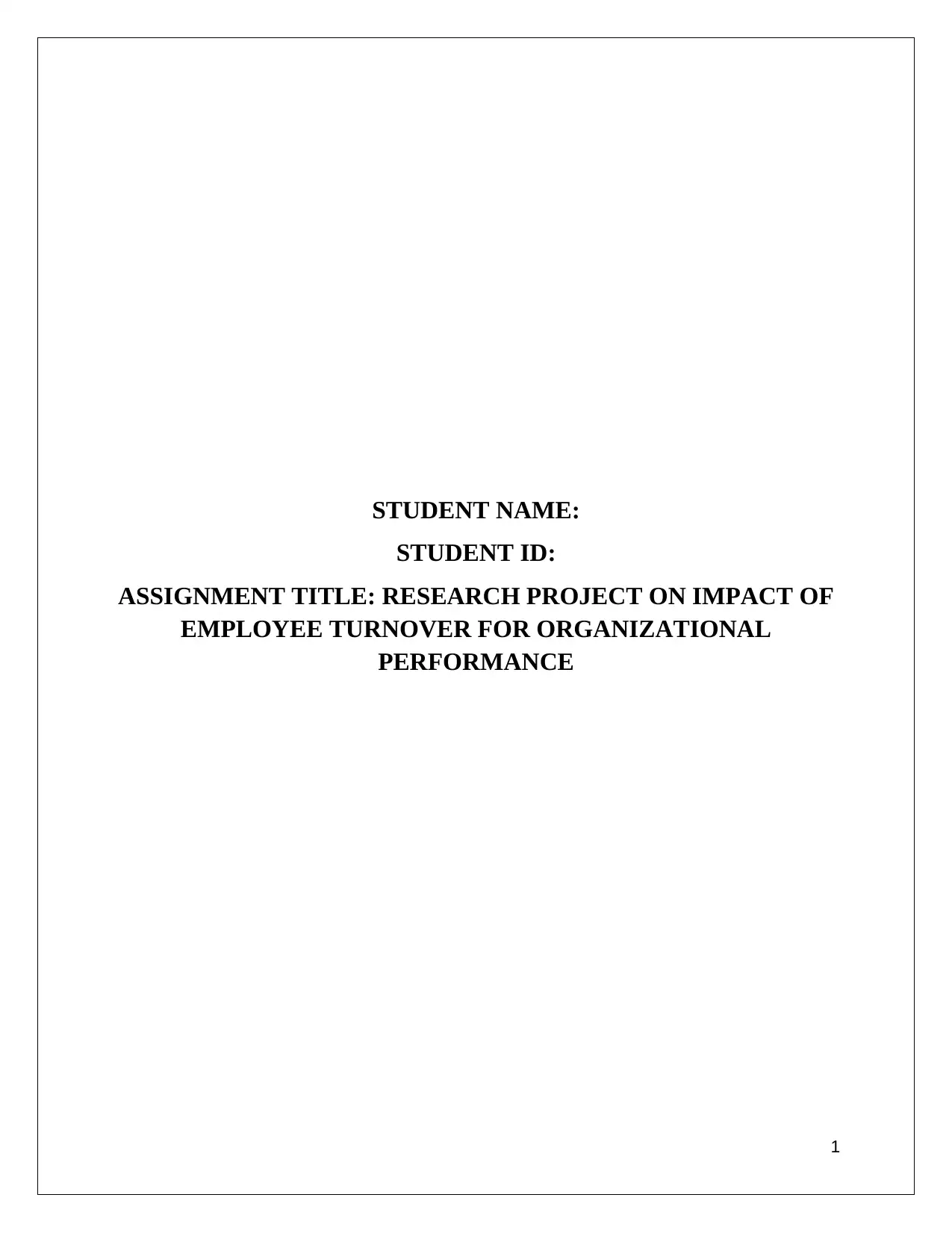
STUDENT NAME:
STUDENT ID:
ASSIGNMENT TITLE: RESEARCH PROJECT ON IMPACT OF
EMPLOYEE TURNOVER FOR ORGANIZATIONAL
PERFORMANCE
1
STUDENT ID:
ASSIGNMENT TITLE: RESEARCH PROJECT ON IMPACT OF
EMPLOYEE TURNOVER FOR ORGANIZATIONAL
PERFORMANCE
1
Paraphrase This Document
Need a fresh take? Get an instant paraphrase of this document with our AI Paraphraser
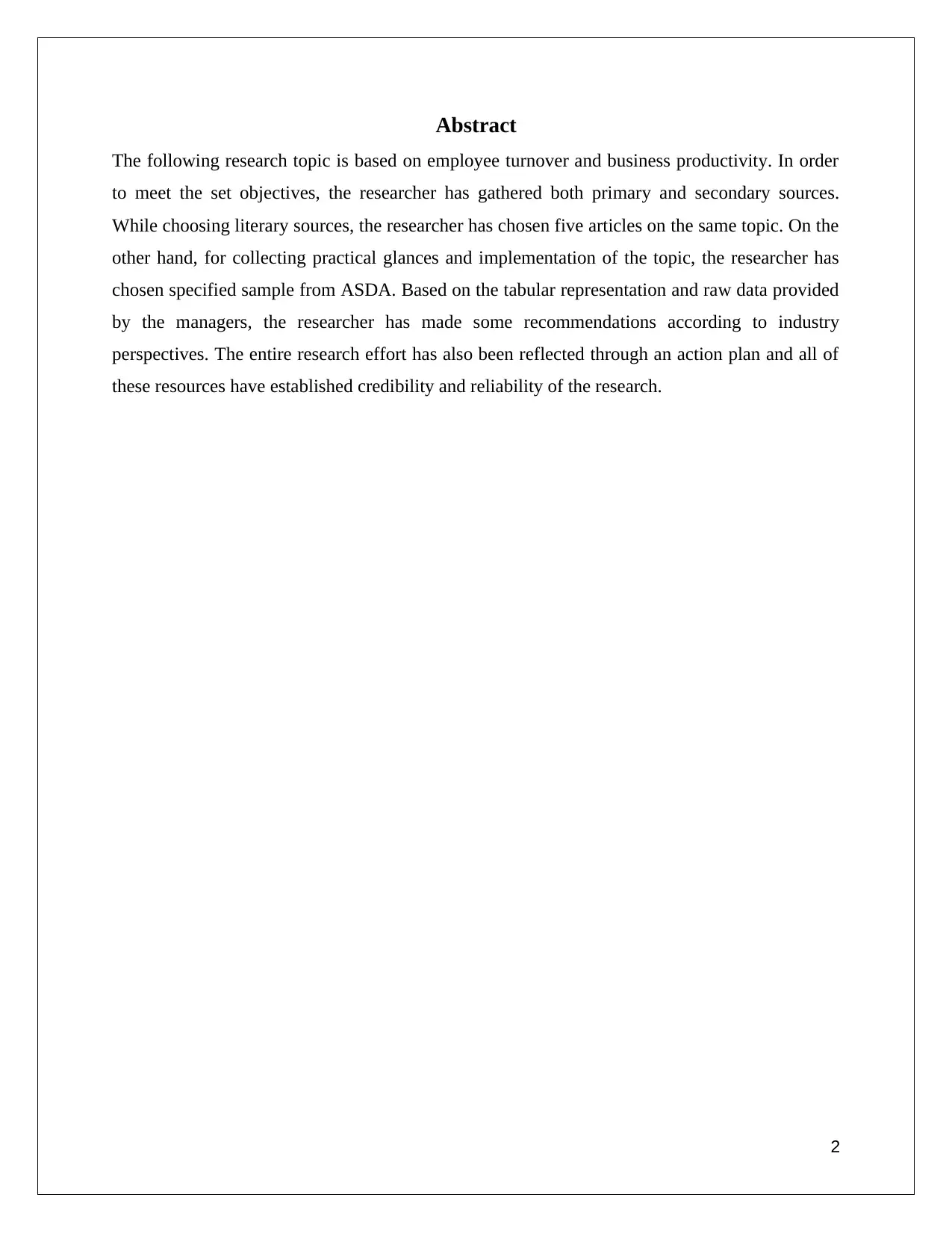
Abstract
The following research topic is based on employee turnover and business productivity. In order
to meet the set objectives, the researcher has gathered both primary and secondary sources.
While choosing literary sources, the researcher has chosen five articles on the same topic. On the
other hand, for collecting practical glances and implementation of the topic, the researcher has
chosen specified sample from ASDA. Based on the tabular representation and raw data provided
by the managers, the researcher has made some recommendations according to industry
perspectives. The entire research effort has also been reflected through an action plan and all of
these resources have established credibility and reliability of the research.
2
The following research topic is based on employee turnover and business productivity. In order
to meet the set objectives, the researcher has gathered both primary and secondary sources.
While choosing literary sources, the researcher has chosen five articles on the same topic. On the
other hand, for collecting practical glances and implementation of the topic, the researcher has
chosen specified sample from ASDA. Based on the tabular representation and raw data provided
by the managers, the researcher has made some recommendations according to industry
perspectives. The entire research effort has also been reflected through an action plan and all of
these resources have established credibility and reliability of the research.
2
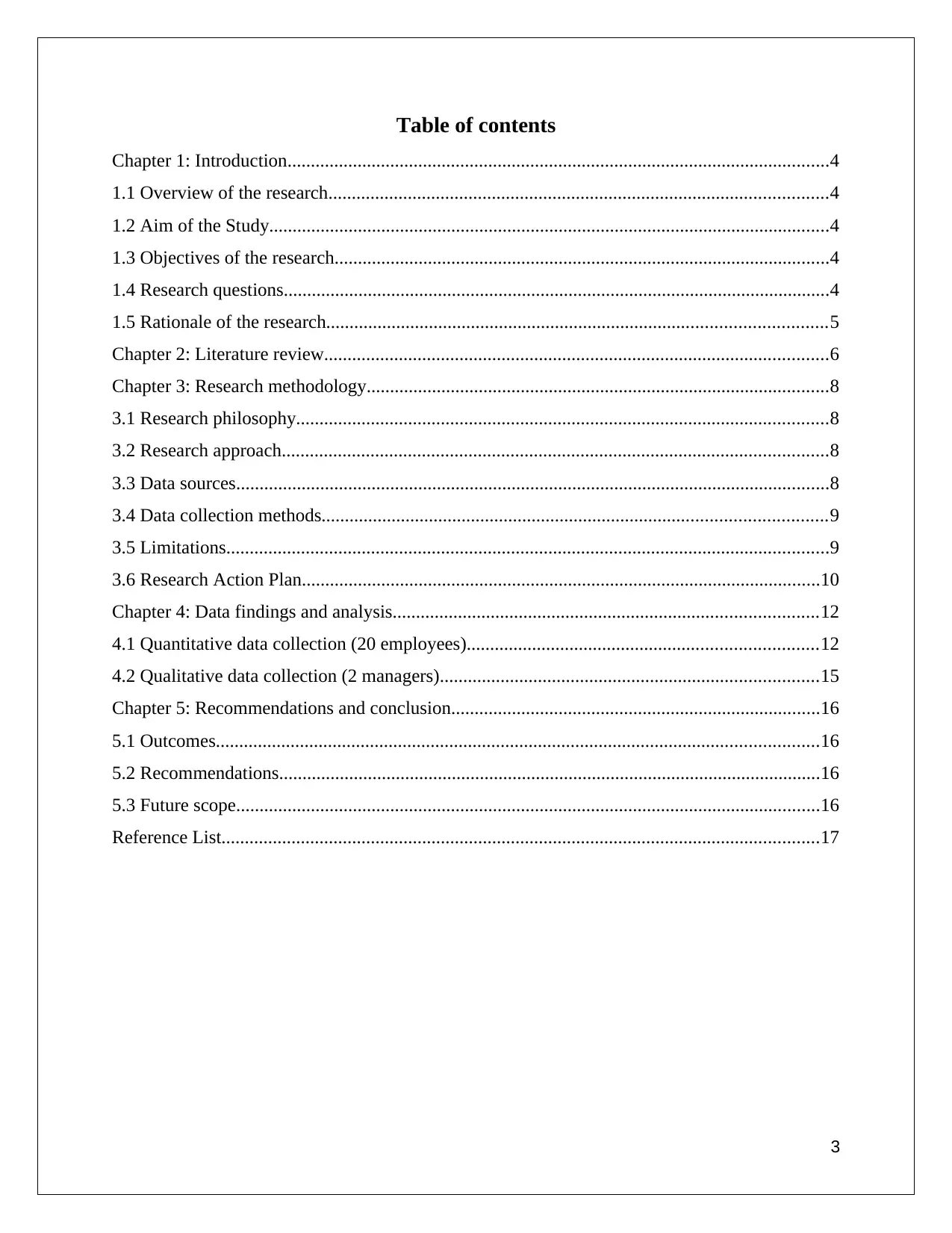
Table of contents
Chapter 1: Introduction....................................................................................................................4
1.1 Overview of the research...........................................................................................................4
1.2 Aim of the Study........................................................................................................................4
1.3 Objectives of the research..........................................................................................................4
1.4 Research questions.....................................................................................................................4
1.5 Rationale of the research...........................................................................................................5
Chapter 2: Literature review............................................................................................................6
Chapter 3: Research methodology...................................................................................................8
3.1 Research philosophy..................................................................................................................8
3.2 Research approach.....................................................................................................................8
3.3 Data sources...............................................................................................................................8
3.4 Data collection methods............................................................................................................9
3.5 Limitations.................................................................................................................................9
3.6 Research Action Plan...............................................................................................................10
Chapter 4: Data findings and analysis...........................................................................................12
4.1 Quantitative data collection (20 employees)...........................................................................12
4.2 Qualitative data collection (2 managers).................................................................................15
Chapter 5: Recommendations and conclusion...............................................................................16
5.1 Outcomes.................................................................................................................................16
5.2 Recommendations....................................................................................................................16
5.3 Future scope.............................................................................................................................16
Reference List................................................................................................................................17
3
Chapter 1: Introduction....................................................................................................................4
1.1 Overview of the research...........................................................................................................4
1.2 Aim of the Study........................................................................................................................4
1.3 Objectives of the research..........................................................................................................4
1.4 Research questions.....................................................................................................................4
1.5 Rationale of the research...........................................................................................................5
Chapter 2: Literature review............................................................................................................6
Chapter 3: Research methodology...................................................................................................8
3.1 Research philosophy..................................................................................................................8
3.2 Research approach.....................................................................................................................8
3.3 Data sources...............................................................................................................................8
3.4 Data collection methods............................................................................................................9
3.5 Limitations.................................................................................................................................9
3.6 Research Action Plan...............................................................................................................10
Chapter 4: Data findings and analysis...........................................................................................12
4.1 Quantitative data collection (20 employees)...........................................................................12
4.2 Qualitative data collection (2 managers).................................................................................15
Chapter 5: Recommendations and conclusion...............................................................................16
5.1 Outcomes.................................................................................................................................16
5.2 Recommendations....................................................................................................................16
5.3 Future scope.............................................................................................................................16
Reference List................................................................................................................................17
3
⊘ This is a preview!⊘
Do you want full access?
Subscribe today to unlock all pages.

Trusted by 1+ million students worldwide
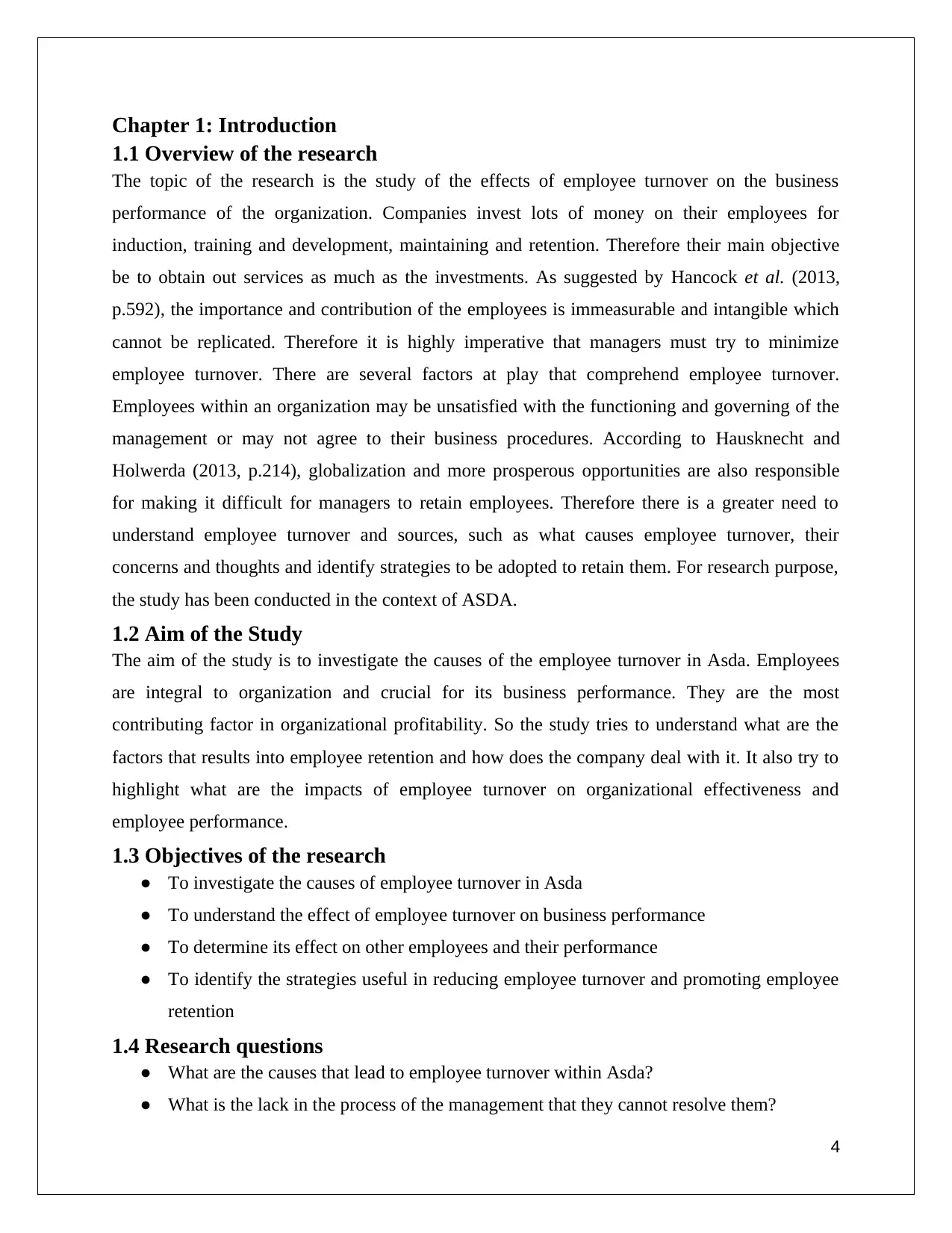
Chapter 1: Introduction
1.1 Overview of the research
The topic of the research is the study of the effects of employee turnover on the business
performance of the organization. Companies invest lots of money on their employees for
induction, training and development, maintaining and retention. Therefore their main objective
be to obtain out services as much as the investments. As suggested by Hancock et al. (2013,
p.592), the importance and contribution of the employees is immeasurable and intangible which
cannot be replicated. Therefore it is highly imperative that managers must try to minimize
employee turnover. There are several factors at play that comprehend employee turnover.
Employees within an organization may be unsatisfied with the functioning and governing of the
management or may not agree to their business procedures. According to Hausknecht and
Holwerda (2013, p.214), globalization and more prosperous opportunities are also responsible
for making it difficult for managers to retain employees. Therefore there is a greater need to
understand employee turnover and sources, such as what causes employee turnover, their
concerns and thoughts and identify strategies to be adopted to retain them. For research purpose,
the study has been conducted in the context of ASDA.
1.2 Aim of the Study
The aim of the study is to investigate the causes of the employee turnover in Asda. Employees
are integral to organization and crucial for its business performance. They are the most
contributing factor in organizational profitability. So the study tries to understand what are the
factors that results into employee retention and how does the company deal with it. It also try to
highlight what are the impacts of employee turnover on organizational effectiveness and
employee performance.
1.3 Objectives of the research
● To investigate the causes of employee turnover in Asda
● To understand the effect of employee turnover on business performance
● To determine its effect on other employees and their performance
● To identify the strategies useful in reducing employee turnover and promoting employee
retention
1.4 Research questions
● What are the causes that lead to employee turnover within Asda?
● What is the lack in the process of the management that they cannot resolve them?
4
1.1 Overview of the research
The topic of the research is the study of the effects of employee turnover on the business
performance of the organization. Companies invest lots of money on their employees for
induction, training and development, maintaining and retention. Therefore their main objective
be to obtain out services as much as the investments. As suggested by Hancock et al. (2013,
p.592), the importance and contribution of the employees is immeasurable and intangible which
cannot be replicated. Therefore it is highly imperative that managers must try to minimize
employee turnover. There are several factors at play that comprehend employee turnover.
Employees within an organization may be unsatisfied with the functioning and governing of the
management or may not agree to their business procedures. According to Hausknecht and
Holwerda (2013, p.214), globalization and more prosperous opportunities are also responsible
for making it difficult for managers to retain employees. Therefore there is a greater need to
understand employee turnover and sources, such as what causes employee turnover, their
concerns and thoughts and identify strategies to be adopted to retain them. For research purpose,
the study has been conducted in the context of ASDA.
1.2 Aim of the Study
The aim of the study is to investigate the causes of the employee turnover in Asda. Employees
are integral to organization and crucial for its business performance. They are the most
contributing factor in organizational profitability. So the study tries to understand what are the
factors that results into employee retention and how does the company deal with it. It also try to
highlight what are the impacts of employee turnover on organizational effectiveness and
employee performance.
1.3 Objectives of the research
● To investigate the causes of employee turnover in Asda
● To understand the effect of employee turnover on business performance
● To determine its effect on other employees and their performance
● To identify the strategies useful in reducing employee turnover and promoting employee
retention
1.4 Research questions
● What are the causes that lead to employee turnover within Asda?
● What is the lack in the process of the management that they cannot resolve them?
4
Paraphrase This Document
Need a fresh take? Get an instant paraphrase of this document with our AI Paraphraser
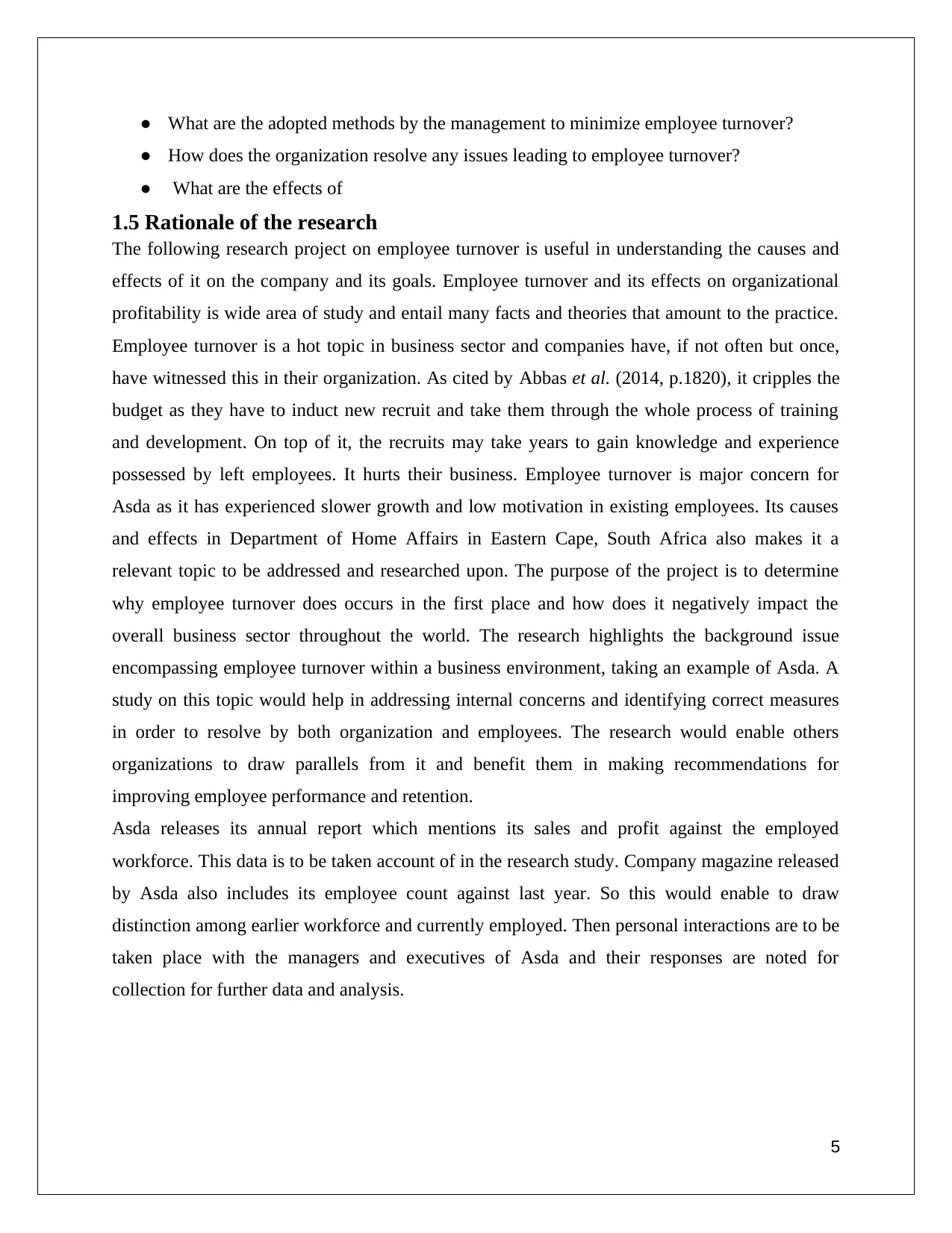
● What are the adopted methods by the management to minimize employee turnover?
● How does the organization resolve any issues leading to employee turnover?
● What are the effects of
1.5 Rationale of the research
The following research project on employee turnover is useful in understanding the causes and
effects of it on the company and its goals. Employee turnover and its effects on organizational
profitability is wide area of study and entail many facts and theories that amount to the practice.
Employee turnover is a hot topic in business sector and companies have, if not often but once,
have witnessed this in their organization. As cited by Abbas et al. (2014, p.1820), it cripples the
budget as they have to induct new recruit and take them through the whole process of training
and development. On top of it, the recruits may take years to gain knowledge and experience
possessed by left employees. It hurts their business. Employee turnover is major concern for
Asda as it has experienced slower growth and low motivation in existing employees. Its causes
and effects in Department of Home Affairs in Eastern Cape, South Africa also makes it a
relevant topic to be addressed and researched upon. The purpose of the project is to determine
why employee turnover does occurs in the first place and how does it negatively impact the
overall business sector throughout the world. The research highlights the background issue
encompassing employee turnover within a business environment, taking an example of Asda. A
study on this topic would help in addressing internal concerns and identifying correct measures
in order to resolve by both organization and employees. The research would enable others
organizations to draw parallels from it and benefit them in making recommendations for
improving employee performance and retention.
Asda releases its annual report which mentions its sales and profit against the employed
workforce. This data is to be taken account of in the research study. Company magazine released
by Asda also includes its employee count against last year. So this would enable to draw
distinction among earlier workforce and currently employed. Then personal interactions are to be
taken place with the managers and executives of Asda and their responses are noted for
collection for further data and analysis.
5
● How does the organization resolve any issues leading to employee turnover?
● What are the effects of
1.5 Rationale of the research
The following research project on employee turnover is useful in understanding the causes and
effects of it on the company and its goals. Employee turnover and its effects on organizational
profitability is wide area of study and entail many facts and theories that amount to the practice.
Employee turnover is a hot topic in business sector and companies have, if not often but once,
have witnessed this in their organization. As cited by Abbas et al. (2014, p.1820), it cripples the
budget as they have to induct new recruit and take them through the whole process of training
and development. On top of it, the recruits may take years to gain knowledge and experience
possessed by left employees. It hurts their business. Employee turnover is major concern for
Asda as it has experienced slower growth and low motivation in existing employees. Its causes
and effects in Department of Home Affairs in Eastern Cape, South Africa also makes it a
relevant topic to be addressed and researched upon. The purpose of the project is to determine
why employee turnover does occurs in the first place and how does it negatively impact the
overall business sector throughout the world. The research highlights the background issue
encompassing employee turnover within a business environment, taking an example of Asda. A
study on this topic would help in addressing internal concerns and identifying correct measures
in order to resolve by both organization and employees. The research would enable others
organizations to draw parallels from it and benefit them in making recommendations for
improving employee performance and retention.
Asda releases its annual report which mentions its sales and profit against the employed
workforce. This data is to be taken account of in the research study. Company magazine released
by Asda also includes its employee count against last year. So this would enable to draw
distinction among earlier workforce and currently employed. Then personal interactions are to be
taken place with the managers and executives of Asda and their responses are noted for
collection for further data and analysis.
5
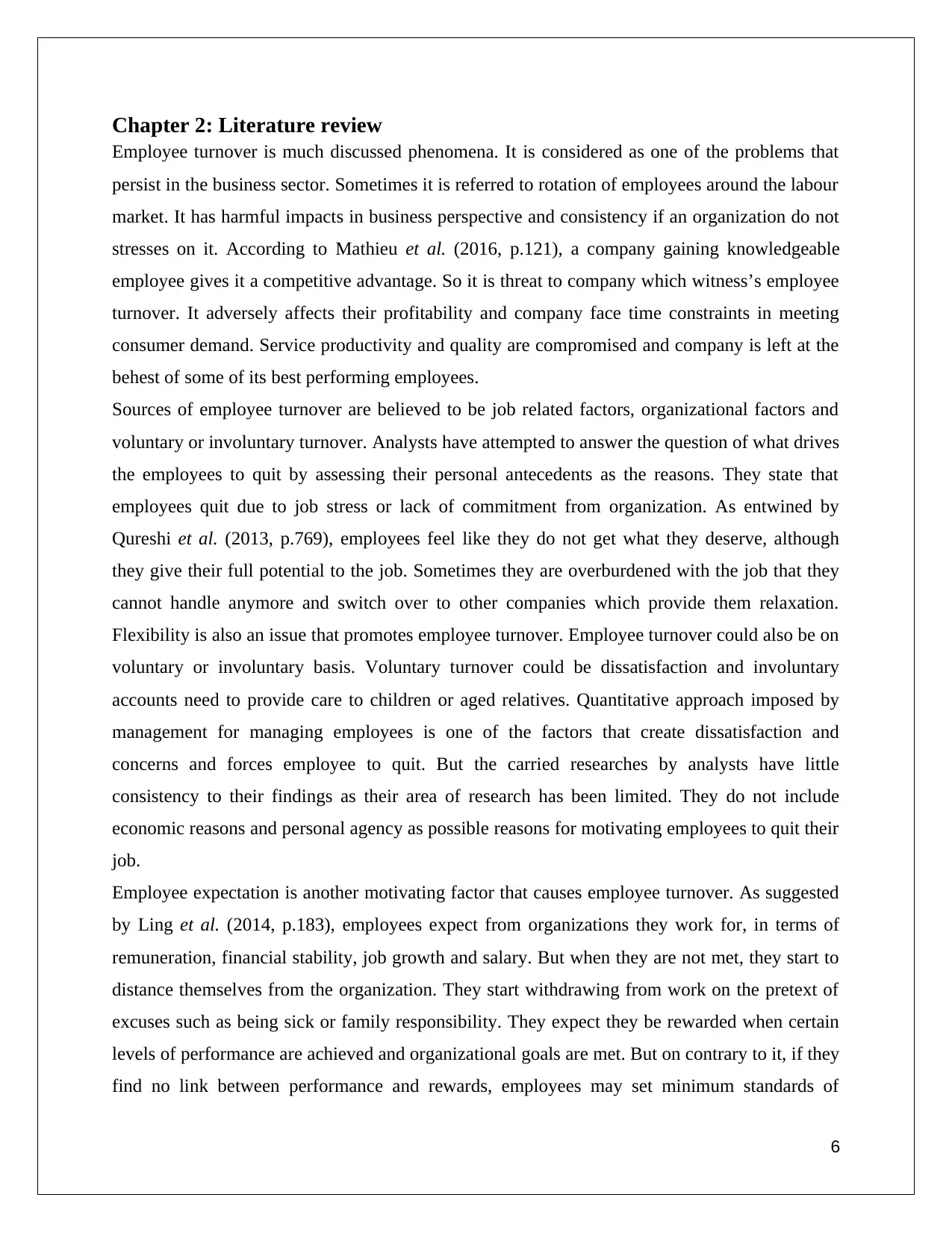
Chapter 2: Literature review
Employee turnover is much discussed phenomena. It is considered as one of the problems that
persist in the business sector. Sometimes it is referred to rotation of employees around the labour
market. It has harmful impacts in business perspective and consistency if an organization do not
stresses on it. According to Mathieu et al. (2016, p.121), a company gaining knowledgeable
employee gives it a competitive advantage. So it is threat to company which witness’s employee
turnover. It adversely affects their profitability and company face time constraints in meeting
consumer demand. Service productivity and quality are compromised and company is left at the
behest of some of its best performing employees.
Sources of employee turnover are believed to be job related factors, organizational factors and
voluntary or involuntary turnover. Analysts have attempted to answer the question of what drives
the employees to quit by assessing their personal antecedents as the reasons. They state that
employees quit due to job stress or lack of commitment from organization. As entwined by
Qureshi et al. (2013, p.769), employees feel like they do not get what they deserve, although
they give their full potential to the job. Sometimes they are overburdened with the job that they
cannot handle anymore and switch over to other companies which provide them relaxation.
Flexibility is also an issue that promotes employee turnover. Employee turnover could also be on
voluntary or involuntary basis. Voluntary turnover could be dissatisfaction and involuntary
accounts need to provide care to children or aged relatives. Quantitative approach imposed by
management for managing employees is one of the factors that create dissatisfaction and
concerns and forces employee to quit. But the carried researches by analysts have little
consistency to their findings as their area of research has been limited. They do not include
economic reasons and personal agency as possible reasons for motivating employees to quit their
job.
Employee expectation is another motivating factor that causes employee turnover. As suggested
by Ling et al. (2014, p.183), employees expect from organizations they work for, in terms of
remuneration, financial stability, job growth and salary. But when they are not met, they start to
distance themselves from the organization. They start withdrawing from work on the pretext of
excuses such as being sick or family responsibility. They expect they be rewarded when certain
levels of performance are achieved and organizational goals are met. But on contrary to it, if they
find no link between performance and rewards, employees may set minimum standards of
6
Employee turnover is much discussed phenomena. It is considered as one of the problems that
persist in the business sector. Sometimes it is referred to rotation of employees around the labour
market. It has harmful impacts in business perspective and consistency if an organization do not
stresses on it. According to Mathieu et al. (2016, p.121), a company gaining knowledgeable
employee gives it a competitive advantage. So it is threat to company which witness’s employee
turnover. It adversely affects their profitability and company face time constraints in meeting
consumer demand. Service productivity and quality are compromised and company is left at the
behest of some of its best performing employees.
Sources of employee turnover are believed to be job related factors, organizational factors and
voluntary or involuntary turnover. Analysts have attempted to answer the question of what drives
the employees to quit by assessing their personal antecedents as the reasons. They state that
employees quit due to job stress or lack of commitment from organization. As entwined by
Qureshi et al. (2013, p.769), employees feel like they do not get what they deserve, although
they give their full potential to the job. Sometimes they are overburdened with the job that they
cannot handle anymore and switch over to other companies which provide them relaxation.
Flexibility is also an issue that promotes employee turnover. Employee turnover could also be on
voluntary or involuntary basis. Voluntary turnover could be dissatisfaction and involuntary
accounts need to provide care to children or aged relatives. Quantitative approach imposed by
management for managing employees is one of the factors that create dissatisfaction and
concerns and forces employee to quit. But the carried researches by analysts have little
consistency to their findings as their area of research has been limited. They do not include
economic reasons and personal agency as possible reasons for motivating employees to quit their
job.
Employee expectation is another motivating factor that causes employee turnover. As suggested
by Ling et al. (2014, p.183), employees expect from organizations they work for, in terms of
remuneration, financial stability, job growth and salary. But when they are not met, they start to
distance themselves from the organization. They start withdrawing from work on the pretext of
excuses such as being sick or family responsibility. They expect they be rewarded when certain
levels of performance are achieved and organizational goals are met. But on contrary to it, if they
find no link between performance and rewards, employees may set minimum standards of
6
⊘ This is a preview!⊘
Do you want full access?
Subscribe today to unlock all pages.

Trusted by 1+ million students worldwide
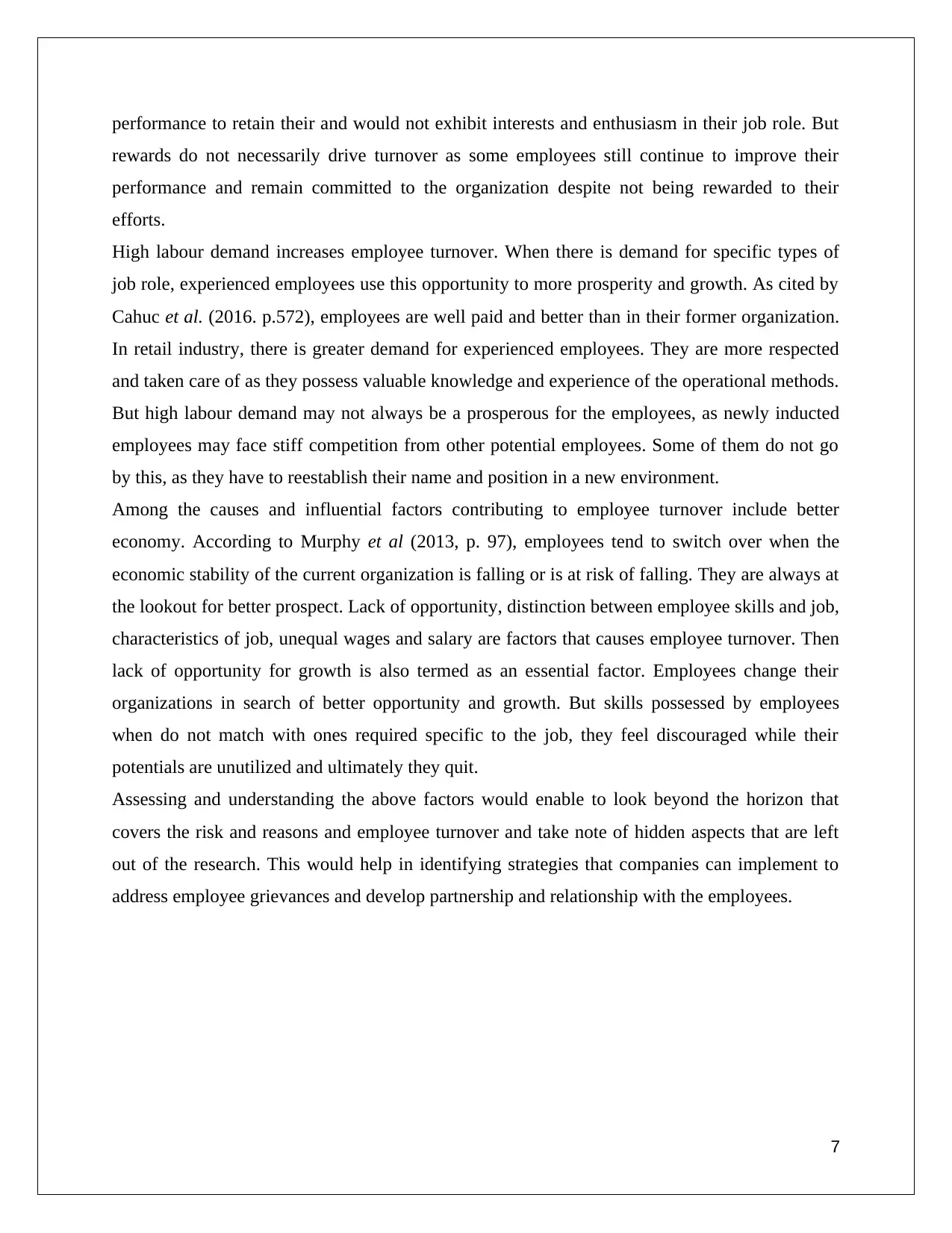
performance to retain their and would not exhibit interests and enthusiasm in their job role. But
rewards do not necessarily drive turnover as some employees still continue to improve their
performance and remain committed to the organization despite not being rewarded to their
efforts.
High labour demand increases employee turnover. When there is demand for specific types of
job role, experienced employees use this opportunity to more prosperity and growth. As cited by
Cahuc et al. (2016. p.572), employees are well paid and better than in their former organization.
In retail industry, there is greater demand for experienced employees. They are more respected
and taken care of as they possess valuable knowledge and experience of the operational methods.
But high labour demand may not always be a prosperous for the employees, as newly inducted
employees may face stiff competition from other potential employees. Some of them do not go
by this, as they have to reestablish their name and position in a new environment.
Among the causes and influential factors contributing to employee turnover include better
economy. According to Murphy et al (2013, p. 97), employees tend to switch over when the
economic stability of the current organization is falling or is at risk of falling. They are always at
the lookout for better prospect. Lack of opportunity, distinction between employee skills and job,
characteristics of job, unequal wages and salary are factors that causes employee turnover. Then
lack of opportunity for growth is also termed as an essential factor. Employees change their
organizations in search of better opportunity and growth. But skills possessed by employees
when do not match with ones required specific to the job, they feel discouraged while their
potentials are unutilized and ultimately they quit.
Assessing and understanding the above factors would enable to look beyond the horizon that
covers the risk and reasons and employee turnover and take note of hidden aspects that are left
out of the research. This would help in identifying strategies that companies can implement to
address employee grievances and develop partnership and relationship with the employees.
7
rewards do not necessarily drive turnover as some employees still continue to improve their
performance and remain committed to the organization despite not being rewarded to their
efforts.
High labour demand increases employee turnover. When there is demand for specific types of
job role, experienced employees use this opportunity to more prosperity and growth. As cited by
Cahuc et al. (2016. p.572), employees are well paid and better than in their former organization.
In retail industry, there is greater demand for experienced employees. They are more respected
and taken care of as they possess valuable knowledge and experience of the operational methods.
But high labour demand may not always be a prosperous for the employees, as newly inducted
employees may face stiff competition from other potential employees. Some of them do not go
by this, as they have to reestablish their name and position in a new environment.
Among the causes and influential factors contributing to employee turnover include better
economy. According to Murphy et al (2013, p. 97), employees tend to switch over when the
economic stability of the current organization is falling or is at risk of falling. They are always at
the lookout for better prospect. Lack of opportunity, distinction between employee skills and job,
characteristics of job, unequal wages and salary are factors that causes employee turnover. Then
lack of opportunity for growth is also termed as an essential factor. Employees change their
organizations in search of better opportunity and growth. But skills possessed by employees
when do not match with ones required specific to the job, they feel discouraged while their
potentials are unutilized and ultimately they quit.
Assessing and understanding the above factors would enable to look beyond the horizon that
covers the risk and reasons and employee turnover and take note of hidden aspects that are left
out of the research. This would help in identifying strategies that companies can implement to
address employee grievances and develop partnership and relationship with the employees.
7
Paraphrase This Document
Need a fresh take? Get an instant paraphrase of this document with our AI Paraphraser
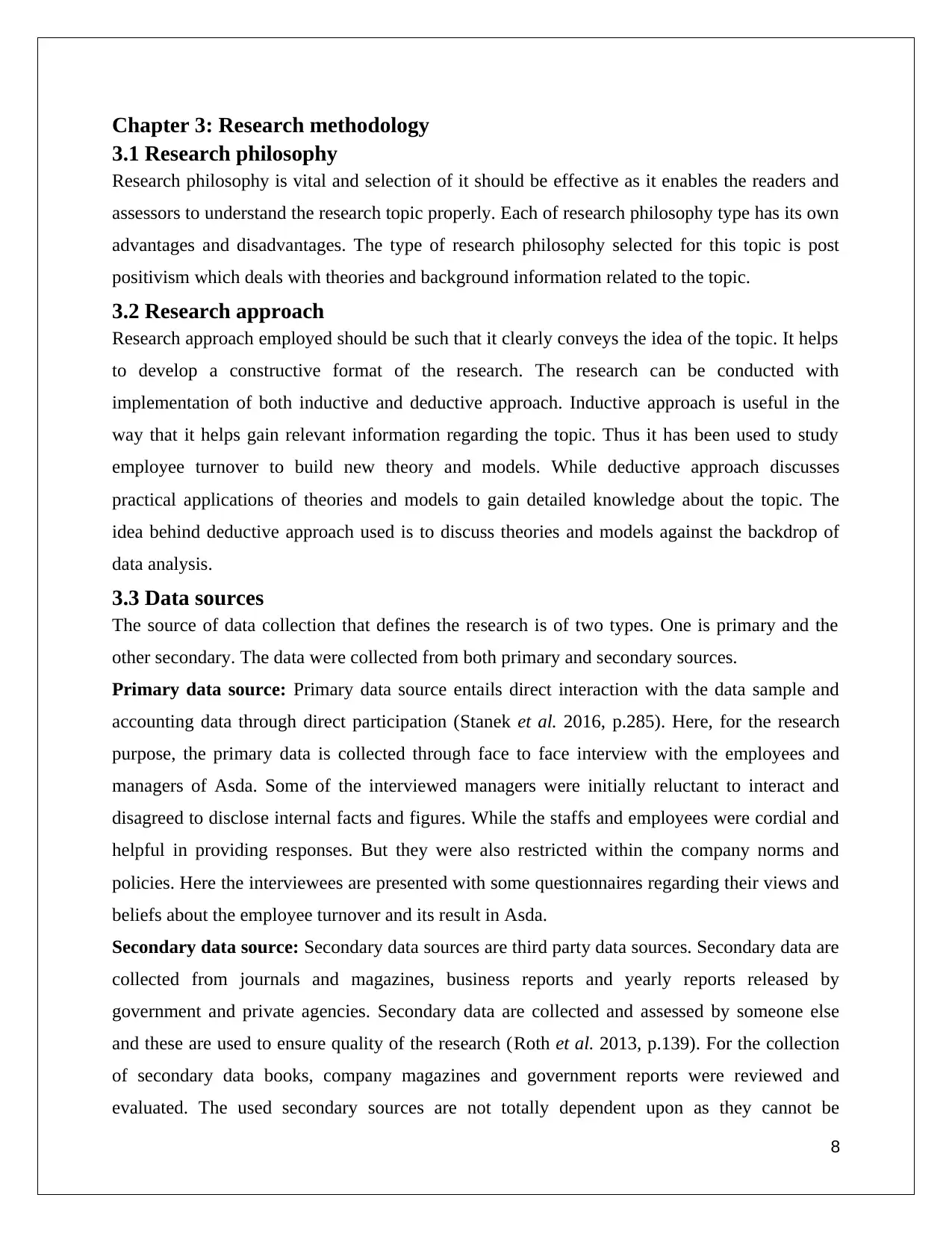
Chapter 3: Research methodology
3.1 Research philosophy
Research philosophy is vital and selection of it should be effective as it enables the readers and
assessors to understand the research topic properly. Each of research philosophy type has its own
advantages and disadvantages. The type of research philosophy selected for this topic is post
positivism which deals with theories and background information related to the topic.
3.2 Research approach
Research approach employed should be such that it clearly conveys the idea of the topic. It helps
to develop a constructive format of the research. The research can be conducted with
implementation of both inductive and deductive approach. Inductive approach is useful in the
way that it helps gain relevant information regarding the topic. Thus it has been used to study
employee turnover to build new theory and models. While deductive approach discusses
practical applications of theories and models to gain detailed knowledge about the topic. The
idea behind deductive approach used is to discuss theories and models against the backdrop of
data analysis.
3.3 Data sources
The source of data collection that defines the research is of two types. One is primary and the
other secondary. The data were collected from both primary and secondary sources.
Primary data source: Primary data source entails direct interaction with the data sample and
accounting data through direct participation (Stanek et al. 2016, p.285). Here, for the research
purpose, the primary data is collected through face to face interview with the employees and
managers of Asda. Some of the interviewed managers were initially reluctant to interact and
disagreed to disclose internal facts and figures. While the staffs and employees were cordial and
helpful in providing responses. But they were also restricted within the company norms and
policies. Here the interviewees are presented with some questionnaires regarding their views and
beliefs about the employee turnover and its result in Asda.
Secondary data source: Secondary data sources are third party data sources. Secondary data are
collected from journals and magazines, business reports and yearly reports released by
government and private agencies. Secondary data are collected and assessed by someone else
and these are used to ensure quality of the research (Roth et al. 2013, p.139). For the collection
of secondary data books, company magazines and government reports were reviewed and
evaluated. The used secondary sources are not totally dependent upon as they cannot be
8
3.1 Research philosophy
Research philosophy is vital and selection of it should be effective as it enables the readers and
assessors to understand the research topic properly. Each of research philosophy type has its own
advantages and disadvantages. The type of research philosophy selected for this topic is post
positivism which deals with theories and background information related to the topic.
3.2 Research approach
Research approach employed should be such that it clearly conveys the idea of the topic. It helps
to develop a constructive format of the research. The research can be conducted with
implementation of both inductive and deductive approach. Inductive approach is useful in the
way that it helps gain relevant information regarding the topic. Thus it has been used to study
employee turnover to build new theory and models. While deductive approach discusses
practical applications of theories and models to gain detailed knowledge about the topic. The
idea behind deductive approach used is to discuss theories and models against the backdrop of
data analysis.
3.3 Data sources
The source of data collection that defines the research is of two types. One is primary and the
other secondary. The data were collected from both primary and secondary sources.
Primary data source: Primary data source entails direct interaction with the data sample and
accounting data through direct participation (Stanek et al. 2016, p.285). Here, for the research
purpose, the primary data is collected through face to face interview with the employees and
managers of Asda. Some of the interviewed managers were initially reluctant to interact and
disagreed to disclose internal facts and figures. While the staffs and employees were cordial and
helpful in providing responses. But they were also restricted within the company norms and
policies. Here the interviewees are presented with some questionnaires regarding their views and
beliefs about the employee turnover and its result in Asda.
Secondary data source: Secondary data sources are third party data sources. Secondary data are
collected from journals and magazines, business reports and yearly reports released by
government and private agencies. Secondary data are collected and assessed by someone else
and these are used to ensure quality of the research (Roth et al. 2013, p.139). For the collection
of secondary data books, company magazines and government reports were reviewed and
evaluated. The used secondary sources are not totally dependent upon as they cannot be
8
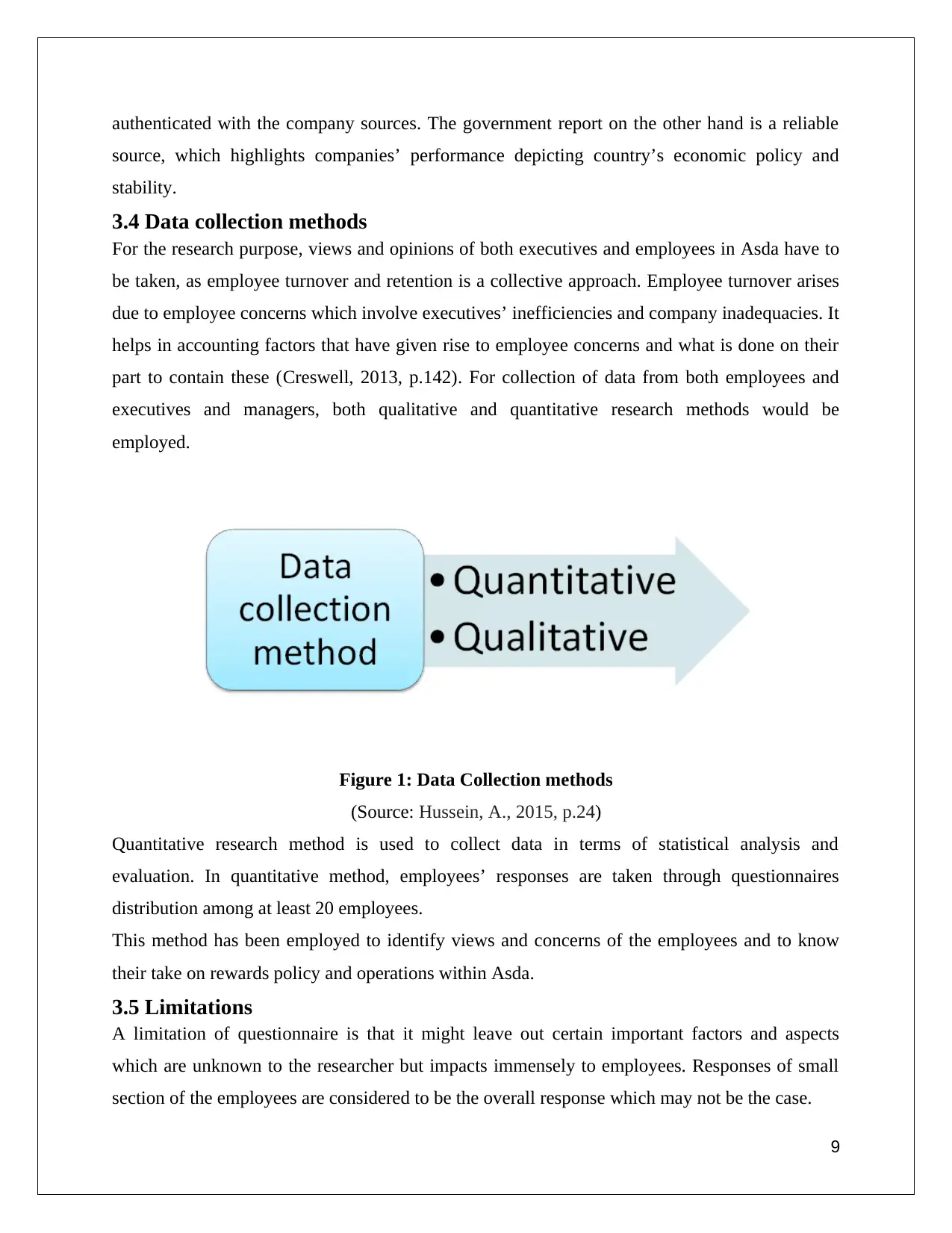
authenticated with the company sources. The government report on the other hand is a reliable
source, which highlights companies’ performance depicting country’s economic policy and
stability.
3.4 Data collection methods
For the research purpose, views and opinions of both executives and employees in Asda have to
be taken, as employee turnover and retention is a collective approach. Employee turnover arises
due to employee concerns which involve executives’ inefficiencies and company inadequacies. It
helps in accounting factors that have given rise to employee concerns and what is done on their
part to contain these (Creswell, 2013, p.142). For collection of data from both employees and
executives and managers, both qualitative and quantitative research methods would be
employed.
Figure 1: Data Collection methods
(Source: Hussein, A., 2015, p.24)
Quantitative research method is used to collect data in terms of statistical analysis and
evaluation. In quantitative method, employees’ responses are taken through questionnaires
distribution among at least 20 employees.
This method has been employed to identify views and concerns of the employees and to know
their take on rewards policy and operations within Asda.
3.5 Limitations
A limitation of questionnaire is that it might leave out certain important factors and aspects
which are unknown to the researcher but impacts immensely to employees. Responses of small
section of the employees are considered to be the overall response which may not be the case.
9
source, which highlights companies’ performance depicting country’s economic policy and
stability.
3.4 Data collection methods
For the research purpose, views and opinions of both executives and employees in Asda have to
be taken, as employee turnover and retention is a collective approach. Employee turnover arises
due to employee concerns which involve executives’ inefficiencies and company inadequacies. It
helps in accounting factors that have given rise to employee concerns and what is done on their
part to contain these (Creswell, 2013, p.142). For collection of data from both employees and
executives and managers, both qualitative and quantitative research methods would be
employed.
Figure 1: Data Collection methods
(Source: Hussein, A., 2015, p.24)
Quantitative research method is used to collect data in terms of statistical analysis and
evaluation. In quantitative method, employees’ responses are taken through questionnaires
distribution among at least 20 employees.
This method has been employed to identify views and concerns of the employees and to know
their take on rewards policy and operations within Asda.
3.5 Limitations
A limitation of questionnaire is that it might leave out certain important factors and aspects
which are unknown to the researcher but impacts immensely to employees. Responses of small
section of the employees are considered to be the overall response which may not be the case.
9
⊘ This is a preview!⊘
Do you want full access?
Subscribe today to unlock all pages.

Trusted by 1+ million students worldwide
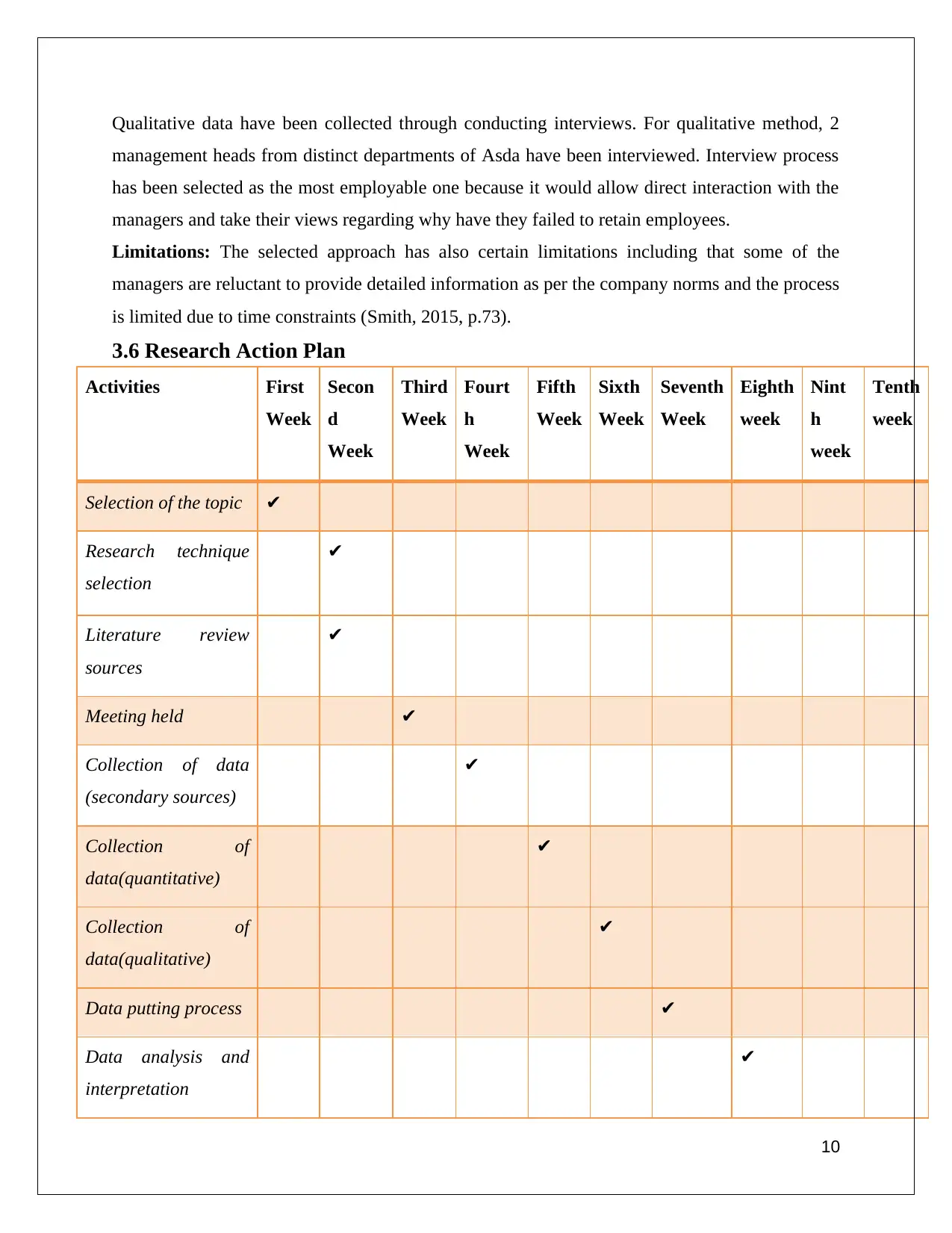
Qualitative data have been collected through conducting interviews. For qualitative method, 2
management heads from distinct departments of Asda have been interviewed. Interview process
has been selected as the most employable one because it would allow direct interaction with the
managers and take their views regarding why have they failed to retain employees.
Limitations: The selected approach has also certain limitations including that some of the
managers are reluctant to provide detailed information as per the company norms and the process
is limited due to time constraints (Smith, 2015, p.73).
3.6 Research Action Plan
Activities First
Week
Secon
d
Week
Third
Week
Fourt
h
Week
Fifth
Week
Sixth
Week
Seventh
Week
Eighth
week
Nint
h
week
Tenth
week
Selection of the topic ✔
Research technique
selection
✔
Literature review
sources
✔
Meeting held ✔
Collection of data
(secondary sources)
✔
Collection of
data(quantitative)
✔
Collection of
data(qualitative)
✔
Data putting process ✔
Data analysis and
interpretation
✔
10
management heads from distinct departments of Asda have been interviewed. Interview process
has been selected as the most employable one because it would allow direct interaction with the
managers and take their views regarding why have they failed to retain employees.
Limitations: The selected approach has also certain limitations including that some of the
managers are reluctant to provide detailed information as per the company norms and the process
is limited due to time constraints (Smith, 2015, p.73).
3.6 Research Action Plan
Activities First
Week
Secon
d
Week
Third
Week
Fourt
h
Week
Fifth
Week
Sixth
Week
Seventh
Week
Eighth
week
Nint
h
week
Tenth
week
Selection of the topic ✔
Research technique
selection
✔
Literature review
sources
✔
Meeting held ✔
Collection of data
(secondary sources)
✔
Collection of
data(quantitative)
✔
Collection of
data(qualitative)
✔
Data putting process ✔
Data analysis and
interpretation
✔
10
Paraphrase This Document
Need a fresh take? Get an instant paraphrase of this document with our AI Paraphraser

Formation of draft ✔
Submission of final
work
✔
11
Submission of final
work
✔
11
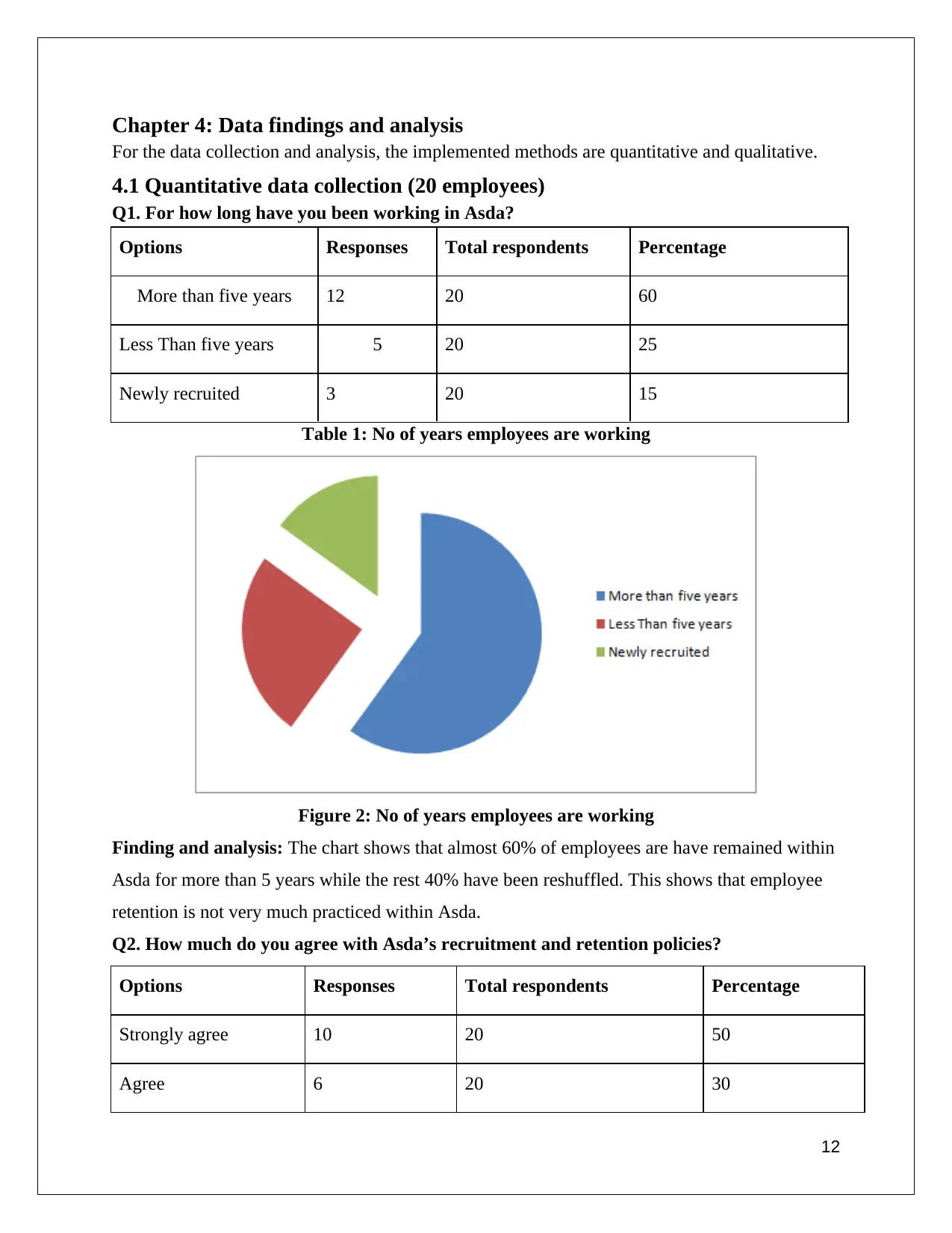
Chapter 4: Data findings and analysis
For the data collection and analysis, the implemented methods are quantitative and qualitative.
4.1 Quantitative data collection (20 employees)
Q1. For how long have you been working in Asda?
Options Responses Total respondents Percentage
More than five years 12 20 60
Less Than five years 5 20 25
Newly recruited 3 20 15
Table 1: No of years employees are working
Figure 2: No of years employees are working
Finding and analysis: The chart shows that almost 60% of employees are have remained within
Asda for more than 5 years while the rest 40% have been reshuffled. This shows that employee
retention is not very much practiced within Asda.
Q2. How much do you agree with Asda’s recruitment and retention policies?
Options Responses Total respondents Percentage
Strongly agree 10 20 50
Agree 6 20 30
12
For the data collection and analysis, the implemented methods are quantitative and qualitative.
4.1 Quantitative data collection (20 employees)
Q1. For how long have you been working in Asda?
Options Responses Total respondents Percentage
More than five years 12 20 60
Less Than five years 5 20 25
Newly recruited 3 20 15
Table 1: No of years employees are working
Figure 2: No of years employees are working
Finding and analysis: The chart shows that almost 60% of employees are have remained within
Asda for more than 5 years while the rest 40% have been reshuffled. This shows that employee
retention is not very much practiced within Asda.
Q2. How much do you agree with Asda’s recruitment and retention policies?
Options Responses Total respondents Percentage
Strongly agree 10 20 50
Agree 6 20 30
12
⊘ This is a preview!⊘
Do you want full access?
Subscribe today to unlock all pages.

Trusted by 1+ million students worldwide
1 out of 18
Related Documents
Your All-in-One AI-Powered Toolkit for Academic Success.
+13062052269
info@desklib.com
Available 24*7 on WhatsApp / Email
![[object Object]](/_next/static/media/star-bottom.7253800d.svg)
Unlock your academic potential
Copyright © 2020–2025 A2Z Services. All Rights Reserved. Developed and managed by ZUCOL.




